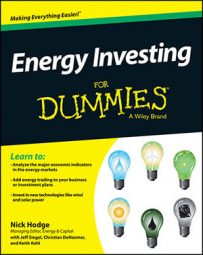Energy investors need to have a basic understanding of natural gas markets on both a regional and global scale. Natural gas is a composition of hydrocarbons formed from millions of years of pressure and heat in thick layers of silt, sand, and mud. It is odorless and tasteless, has no discernible color, and more important, is combustible.
Its combustibility is the characteristic that makes it so valuable. Burning natural gas provides you with the vital energy you use in everyday life. You can cook your food with it, heat your home, and use it to generate electricity.
Because of its odorless nature, distributors and utilities add a harmless chemical called mercaptan to natural gas. This chemical gives natural gas its distinctive smell, usually described as rotten cabbage or eggs. The mercaptan is primarily added for safety purposes (imagine the increased danger of gas leaks without it!).
The everyday natural gas you come across is nearly all methane because it has been refined. But when it first comes out of the ground, it has a completely different makeup. Like crude oil, natural gas must be refined into usable fuels. The makeup of the raw gas is between 70 and 90 percent methane and up to 20 percent ethane.
Raw gas also contains smaller quantities of several other gases, including carbon dioxide, oxygen, nitrogen, hydrogen sulfide, propane, and butane.
Typically, there are two types of natural gas production. Oil and gas companies often target specific gas fields depending on the price environment. The two main categories of natural gas are
Dry natural gas: Production that’s composed of nearly all methane. In the United States, natural gas is considered dry when it has less than 0.1 gallon of heavier hydrocarbons (like propane and butane) for every 1,000 cubic feet. Dry gas is what’s delivered to consumers after the impurities have been removed.
Wet natural gas: Whenever you hear a company talk about wet gas, it means the gas has a greater presence of heavier hydrocarbons. These hydrocarbons are generally separated from the gas in the form of a liquid during natural gas processing. These natural gas liquids (NGLs) hold value for oil and gas companies because they can be sold on the market.
Companies typically report their oil and gas production in terms of barrels of oil equivalent (BOEs). Essentially, one BOE is the amount of energy generated by burning one barrel of crude oil. One BOE is roughly equal to 5,800 cubic feet of natural gas. However, the U.S. Geological Survey (USGS) calculates that approximately 6,000 cubic feet of natural gas is one barrel of oil equivalent.
Natural gas can be measured in several ways. The two you see the most are
Cubic feet for volume, which is used in standard natural gas futures contracts
British thermal unit (Btu) for energy content, which is the amount of energy necessary to heat 1 pound of water by 1 degree Fahrenheit
When converting between the two, note that 1 cubic foot is equal to approximately 1,027 Btus. The table shows you the most common natural gas volume and energy equivalent terms with abbreviations for each.
| Natural Gas Volumes/Equivalents | Abbreviations |
|---|---|
| One cubic foot | 1 cf |
| One thousand cubic feet | 1 Mcf |
| One million cubic feet | 1 Mmcf |
| One billion cubic feet | 1 Bcf |
| One trillion cubic feet | 1 Tcf |
| One cubic foot of natural gas equivalent | cfe |
| One thousand cubic feet of natural gas equivalent | Mcfe |
| One million cubic feet of natural gas equivalent | Mmcfe |
| One billion cubic feet of natural gas equivalent | Bcfe |
| One trillion cubic feet of natural gas equivalent | Tcfe |
For perspective, the United States consumed in excess of 25.5 trillion cubic feet (Tcf) of natural gas in 2012, and the world consumed around 119 Tcf.

